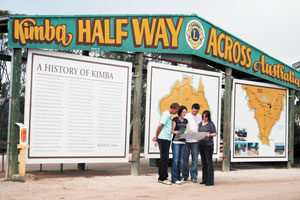By working closely with and as part of the Community we can make the difference
The District Council of Kimba is located in the northeastern portion of South Australia’s Eyre Peninsula. Strategically located on the Eyre Highway, which forms part of National Highway One, Kimba is 475 kilometres from Adelaide, 155 kilometres from Port Augusta and 315 kilometres from Ceduna.
It is geographically halfway across Australia and is well known as the ‘Gateway to the Gawler Ranges’.
Neighbouring towns include Cleve (75 kilometres south), Kyancutta (90 kilometres west) and Whyalla (120 kilometres east).
The economy of the area is primarily agriculture based, with the township being largely a rural service centre for the surrounding agricultural community.
Tourism is set to become a greater part of the local community, with nearby conservation parks and the Gawler Ranges continually gaining popularity among tourist markets. Mining activity across the west coast of South Australia also continues to gain momentum.
While several mining prospects are in planning or feasibility stages, some are nearing the startup stage.
Just 40 kilometres to the north of Kimba, Ironclad Mining is one company not far off a startup.
Council is very welcoming of the mine and hopes that some of the overflow of personal and maintenance activities needed at the site can assist Kimba and surrounding communities.
Waste management
Like all councils, Kimba’s waste management costs continue to use up a substantial part of its rates revenue – approximately 15 per cent. Accordingly, early in 2006/2007, Council agreed to change direction in the pickup and disposal of rubbish.
Cardboard, newsprint and plastic containers were taking up substantial room in refuse pits and were shortening the life of Council’s refuse site. As such, Council purchased a mobile baler that could produce
200 kilogram bales, and from here a recycling program commenced.
Sheds and recycling bins were built at the refuse site entrance with grant funding assistance from Zero Waste – a South Australian Government organisation established to promote waste management practices that reduce waste to landfill. In addition, a very successful recycling pickup was introduced in 2008, operating one day per fortnight.
Council also agreed to introduce a yearly waste management fee for Kimba residents, which allows as many trips to the tip per year as they like. Rural residents who do not have a weekly bin service can purchase a refuse tip access card for a cheaper price. While the charge only raises approximately 25 per cent of the overall cost of rubbish collection, recycling and disposal, Council feels it is important as an acknowledgement of the overall cost.
Freight costs are still the biggest issue for councils located a substantial distance from major centres. Kimba transports its cardboard to Adelaide at a cost of $60 per tonne and newsprint is sold to Whyalla.
In 2006, Whyalla City Council, Kimba, Cleve and Franklin Harbour District Councils decided to form the Eastern Eyre waste management group in an effort to assist with the ongoing improvement in the collection, recycling and disposal of waste. The group meets bimonthly to discuss issues and inspect improvements being made in each town.
Since Kimba commenced recycling, it has saved 19 tonnes of cardboard, as well as 60 tonnes of newsprint and bales of plastic from going to landfill.
Improving Kimba’s roads
In February 2006 the District Council of Kimba applied to the Federal Government under its Auslink Program to fund the construction and sealing of
13 kilometres of Buckleboo road.
The railway line between Buckleboo and Kimba was used to transport grain from the silos at Buckleboo to Kimba. Following its closure in 2006, more trucks began using the 13 kilometre stretch of road between
the two towns, causing significant damage and increasing maintenance costs.
Council approached then Federal Member for Grey, Barry Wakelin, and a subsequent visit to Kimba was made by then Minister for Local Government Territories and Roads, Jim Lloyd.
Following this, Council was successful in receiving a grant of $225,000 towards the total project cost of $1.75 million.
The road was constructed over a two year period and completed in 2008. It is hoped that somewhere down the track, Council might be successful in gaining further grants to complete the remaining five kilometres connecting the road to the silos.
Kimba has also been busy working on another significant road project.
In 2001 it partnered with the District Council of Franklin Harbour to make a joint application for a Special Local Road Grant.
The Special Local Road Program (SLRP) was established by South Australian councils in 1986 and uses funding from the Federal and South Australian Governments.
Kimba and Cowell are using their funding to construct and seal a
93 kilometre stretch of road between the two towns. The Kimba section amounts to
45 kilometres and Franklin Harbour’s section is 48 kilometres.
Each council is contributing a third of the $9.5 million costs, with the SLRP providing the remaining proportion.
Both councils have been working steadily to complete the work and the job is expected to be completed by 30 June 2010.
While the completion of this road will be an important milestone in connecting the two towns, the hidden bonus is that it has allowed both councils to employ extra staff and contractors from around the district.
Wastewater reuse scheme in the works
During 2009, Kimba, along with many other South Australian councils, agreed to make a joint submission through the Local Government Association of South Australia (LGASA) to the Federal Government for funding to assist in developing and constructing schemes for the use of wastewater.
While the amount that LGASA applied for was reduced by approximately 50 per cent, councils still agreed to proceed with their original proposals, while others did so in a modified way.
To lessen the amount of water used at its recreation reserve, Kimba’s proposal was to use water from its community Wastewater Management Scheme to water the ovals.
A previous consultancy with GHD Pty Ltd had indicated that the wastewater could deliver
93 per cent of the water needed for the oval.
The scheme will cost approximately $272,300, with council contributing up to $190,000 of the overall costs.
The holding pond has been built, and a filtration shed, power to the site and a 50,000 gallon tank at the oval have been completed.
The filtration system and approximately
17 kilometres of piping to connect the two sites will be installed shortly.
All going well, the first recycled water to be used on the oval will be in the summer of 2010–2011.








